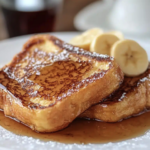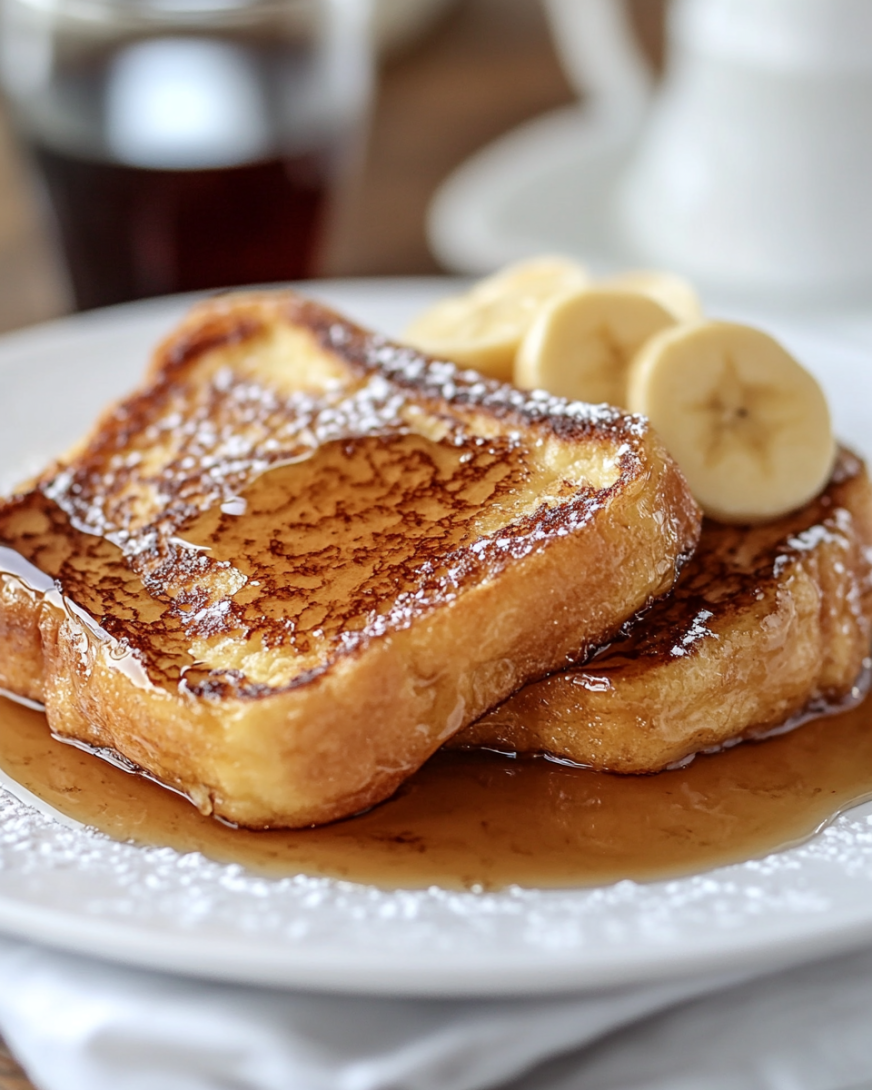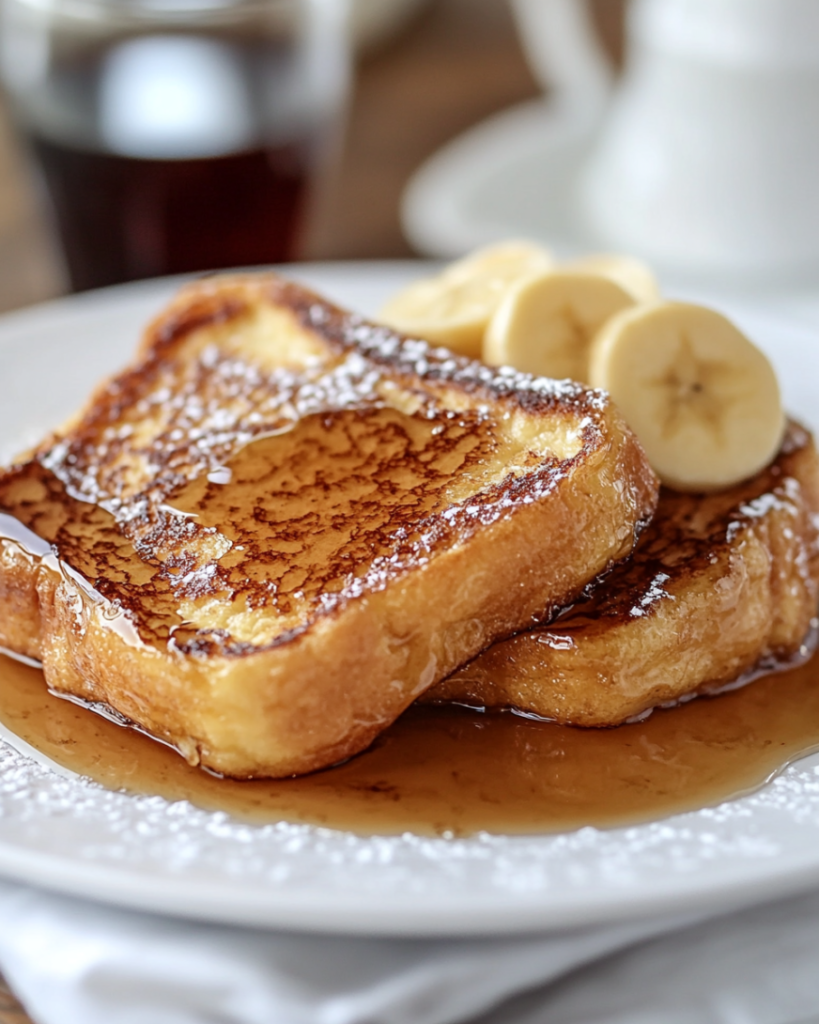French toast is a breakfast staple that combines simplicity with deliciousness. Whether you’re serving it up for a weekend brunch or a special occasion, this classic dish never fails to please. Here’s everything you need to know to create the perfect French toast, including tips, variations, and serving suggestions.
Ingredients
- 4 large eggs
- 1 cup milk (whole milk is ideal for a richer flavor)
- 1 tablespoon sugar (optional, for a touch of sweetness)
- 1 teaspoon vanilla extract
- 1/2 teaspoon ground cinnamon (optional, for added warmth)
- 8 slices of bread (thick slices, like brioche or challah, work best)
- Butter (for frying)
Instructions
- Prepare the Egg Mixture: In a large bowl, whisk together the eggs, milk, sugar (if using), vanilla extract, and ground cinnamon. Make sure the mixture is well combined.
- Heat the Pan: Place a skillet or griddle over medium heat and add a pat of butter. Allow it to melt and start to bubble, but not brown.
- Dip the Bread: Quickly dip each slice of bread into the egg mixture, making sure both sides are coated but not soaked.
- Cook the French Toast: Place the coated bread slices in the hot skillet. Cook for about 2-3 minutes on each side, or until golden brown and crispy.
- Serve Warm: Transfer the cooked French toast to a plate. Serve immediately with your favorite toppings.
Serving Suggestions
- Classic Toppings: Dust with powdered sugar, drizzle with maple syrup, and add a pat of butter.
- Fresh Fruit: Top with fresh berries, bananas, or apples.
- Nut Butters: Spread with almond butter or peanut butter for a protein-packed twist.
- Whipped Cream: Add a dollop of whipped cream for extra indulgence.
Tips for Perfect French Toast
- Bread Choice: Use day-old bread or slightly stale bread for the best texture. Fresh bread can become too soggy.
- Temperature Control: Cook on medium heat to ensure that the French toast cooks through without burning.
- Flavor Variations: Experiment with flavored extracts or spices, such as nutmeg or almond extract, to customize the flavor.
FAQs
Can I make French toast ahead of time?
Yes, you can make French toast ahead of time. Simply cook it, then cool and freeze the slices. Reheat in a toaster or oven before serving.
Can I use dairy-free milk?
Absolutely! Almond milk, soy milk, or oat milk can be used as substitutes for dairy milk.
What type of bread is best for French toast?
Thick, sturdy breads like brioche, challah, or Texas toast are ideal because they hold up well to soaking and frying.
Conclusion
This French toast recipe is a delightful breakfast option that’s easy to make and incredibly versatile. Whether you keep it classic with syrup and butter or get creative with toppings, this dish is sure to become a favorite in your breakfast rotation. Enjoy the deliciously crispy edges and soft, custardy center of homemade French toast!
Serving and Storage Tips for the Perfect French Toast
Serving Tips
- Serve Immediately: French toast is best enjoyed fresh off the skillet while it’s still warm and crispy. Serve it directly from the pan for the best texture.
- Garnish: Add a touch of elegance with a dusting of powdered sugar, a drizzle of maple syrup, or a sprinkle of cinnamon. Fresh fruit, such as berries or sliced bananas, can enhance both flavor and presentation.
- Accompaniments: Pair your French toast with side dishes like crispy bacon, sausage links, or a fresh fruit salad for a well-rounded breakfast.
- Toppings: Get creative with toppings. Consider adding a dollop of whipped cream, a spoonful of fruit compote, or a spread of nut butter. For a decadent twist, you might try a drizzle of chocolate sauce or a scoop of vanilla ice cream.
- Syrup and Sauces: Offer a variety of syrups and sauces, such as maple syrup, honey, or even flavored syrups like raspberry or caramel, to cater to different tastes.
Storage Tips
- Refrigeration: If you have leftovers, let the French toast cool to room temperature before placing it in an airtight container. Store it in the refrigerator for up to 3 days.
- Freezing: For longer storage, freeze the cooked French toast. Place the slices on a baking sheet to freeze individually, then transfer them to a freezer-safe bag or container. Frozen French toast can be stored for up to 3 months.
- Reheating: To reheat French toast, you can use a toaster, toaster oven, or conventional oven. For the toaster, simply toast until heated through. In the oven, preheat to 350°F (175°C) and heat for about 10-15 minutes, or until warmed and crispy. You can also reheat in a skillet over medium heat.
- Avoid Soggy French Toast: To prevent French toast from becoming soggy during storage, make sure it’s completely cooled before storing. Avoid stacking slices directly on top of each other; instead, place a piece of parchment paper between slices.
By following these serving and storage tips, you can ensure that your French toast remains delicious whether you’re enjoying it fresh or reheating leftovers.
1. Can I use any type of bread for French toast?
Yes, you can use various types of bread for French toast. Thick, sturdy breads like brioche, challah, and Texas toast are ideal because they absorb the egg mixture well without becoming too soggy. However, you can also use whole grain bread, sourdough, or even cinnamon raisin bread for a different flavor profile.
2. How can I make French toast gluten-free?
To make gluten-free French toast, use gluten-free bread and ensure all other ingredients are gluten-free as well. Many stores offer gluten-free bread options that work well in this recipe. Simply follow the same steps as with regular bread, adjusting the cooking time if necessary.
3. Can I prepare the egg mixture in advance?
Yes, you can prepare the egg mixture ahead of time. Whisk together the eggs, milk, and any additional ingredients, then store it in an airtight container in the refrigerator for up to 24 hours. Just give it a good whisk before using, as the ingredients may settle.
4. How can I prevent French toast from becoming soggy?
To prevent sogginess, avoid soaking the bread too long. Dip each slice quickly into the egg mixture, ensuring it’s coated but not saturated. Using slightly stale or day-old bread helps it hold its shape better during cooking. Additionally, cook the French toast on medium heat to ensure it cooks evenly without becoming too mushy.

French Toast Recipe
- Prep Time: 10 minutes
- Cook Time: 15 minutes
- Total Time: 25 minutes
- Yield: 4 servings 1x
- Category: Breakfast
- Method: Stovetop
- Cuisine: American
Description
This classic French Toast recipe is perfect for a delicious and easy breakfast. Slices of bread are soaked in a rich, creamy custard, then cooked until golden and crispy on the outside while remaining soft on the inside. Serve with maple syrup, fresh fruit, or your favorite toppings for a comforting morning treat!
Ingredients
- 4 large eggs
- 1 cup whole milk (or any milk of choice)
- 2 tbsp granulated sugar
- 1 tsp vanilla extract
- 1 tsp ground cinnamon (optional)
- Pinch of salt
- 8 slices of bread (brioche, challah, or white bread work best)
- 2 tbsp butter, for cooking
- Maple syrup, powdered sugar, and fresh fruit for serving (optional)
Instructions
- Prepare the Custard: In a large bowl, whisk together eggs, milk, sugar, vanilla extract, cinnamon, and a pinch of salt until well combined.
- Soak the Bread: Dip each slice of bread into the custard mixture, allowing it to soak for about 15-20 seconds per side. Make sure the bread absorbs the mixture but isn’t too soggy.
- Preheat the Pan: Heat a large skillet or griddle over medium heat and add a tablespoon of butter. Swirl to coat the pan.
- Cook the French Toast: Place the soaked bread slices onto the hot skillet. Cook for 2-3 minutes per side, or until golden brown and cooked through. You may need to cook in batches, adding more butter as needed.
- Serve: Serve the French toast hot with your favorite toppings like maple syrup, powdered sugar, fresh berries, or whipped cream.
Notes
- For extra flavor, try adding a pinch of nutmeg or a splash of orange juice to the custard.
- Day-old bread works best as it absorbs the custard without getting too soggy.
- To keep French toast warm while cooking in batches, place cooked slices on a baking sheet in a 200°F (93°C) oven.


